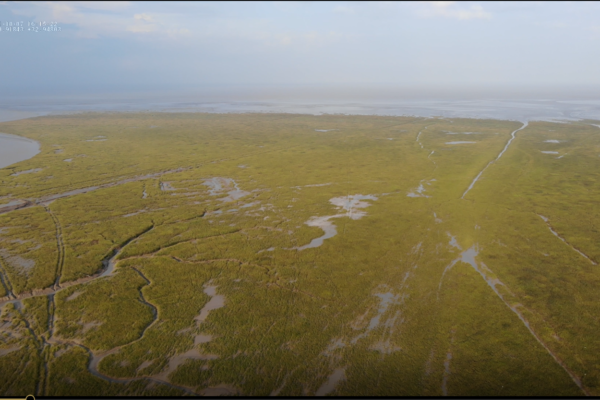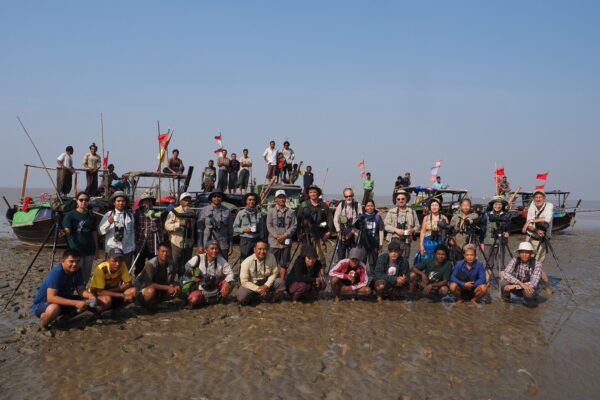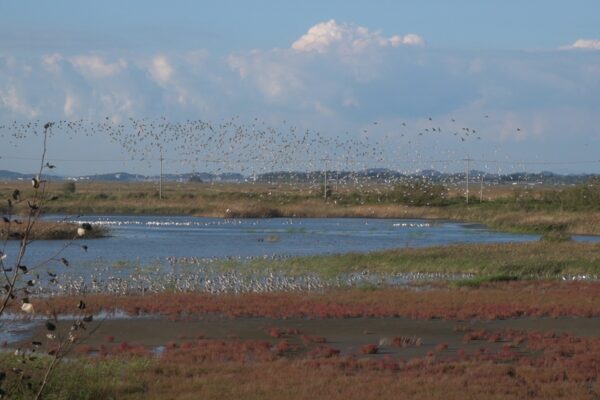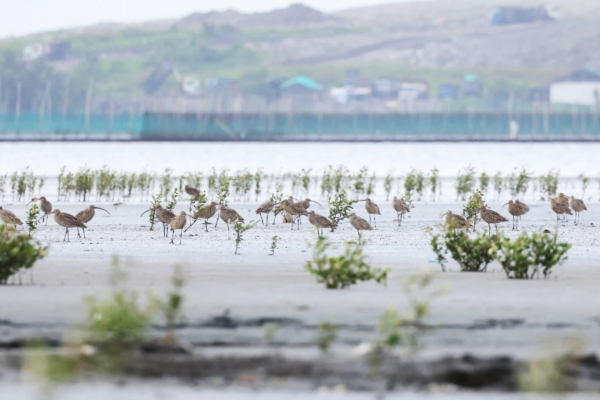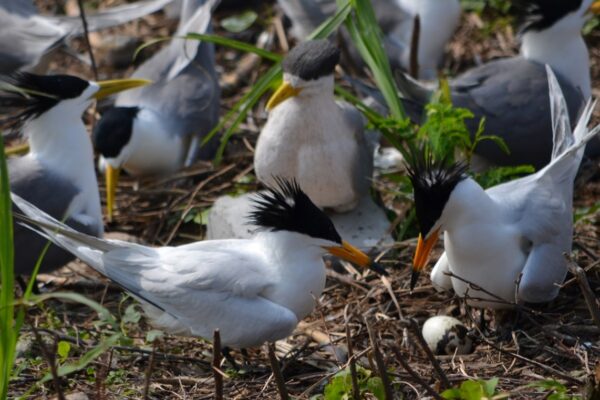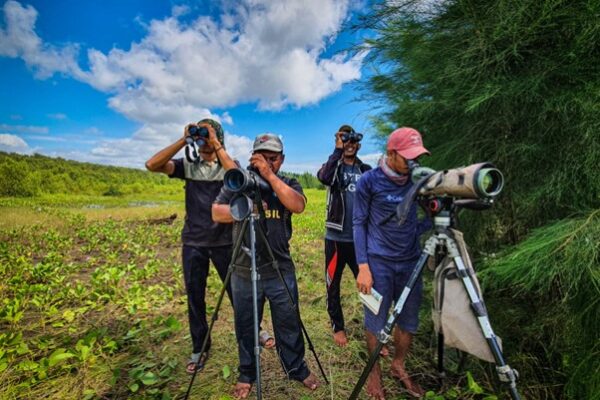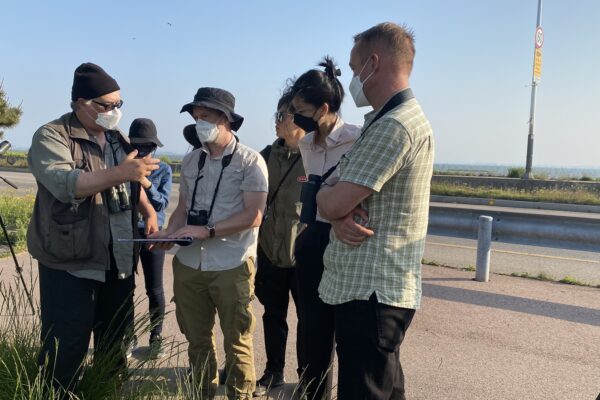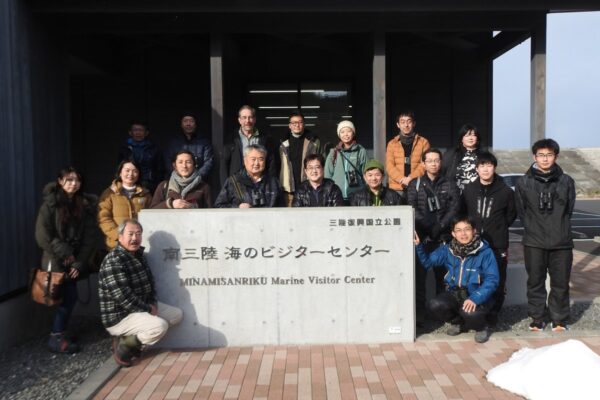-
An Overview of China’s Policy on Spartina Control
Spartina in the estuary © Paulson Institute Mid-February 2023, five Chinese government departments, including the National Forestry and Grassland Administration, together with relevant departments of the State Council, issued the Special Action Plan for the Prevention and Control of Spartina (2022-2025), which sets the goal of effectively controlling Spartina alterniflora throughout China by 2025, with a removal rate of over 90% in all provinces. The Action Plan is undoubtedly a shot in the arm for the coastal provinces to triumph over this invasive Spartina cordgrass and safeguard coastal ecosystems. Spartina cordgrass is native to the east coast of North America and the Gulf of Mexico, and was introduced to China for scientific research and utilization in 1979. Due to its salt tolerance and flood resistance, strong fecundity and well-developed root system, it was considered to be the best plant for promoting sedimentation, protecting embankments, and facilitating siltation and land formation. In the following 20 years, Spartina was widely introduced in many estuaries and mudflats of coastal China. However, there have been unforeseen negative consequences. With artificial planting and natural spread, Spartina now grows on coastal mudflats from Liaoning in the north to Hainan in the south, severely altering the natural environment and ecosystem processes of China's coastal wetlands. This, in turn, has negatively impacted biodiversity and ecosystem service values, and caused significant losses to aquaculture and shipping industries, among others. The history of Spartina control in China can be traced back to the late 1990s, when some scholars pointed out the danger of "widespread and uncurbed growth of Spartina" and recommended thorough research and development of site-specific eradication plans before implementing control projects. Later, as biological invasion became a new research topic of high interest to Chinese ecologists, the harmfulness of Spartina was further revealed, drawing the attention of the Chinese government. In order to tighten the prevention and control of Spartina, the Ministry of Ecology and Environment (formerly SEPA) included Spartina in the List of Invasive Alien Species (First Batch) in 2003, and the Ministry of Agriculture and Rural Affairs (formerly Ministry of Agriculture) included Spartina in the List of Invasive Alien Species for Key Nationwide Efforts of Control (First Batch) in 2013. Although Spartina was classed as an invasive species by China, some scholars suggested recognizing its positive ecological effects, such as wind and wave resistance, siltation and land formation, and carbon sequestration thus balancing the negative ecological effects. Since there was no strict legal basis to regulate exotic plants management at the time, and the two-sided nature of Spartina's ecological benefits had diminished the determination at the local level to eradicate this weed, control measures were not adopted fast enough to curb its rapid spread. Even in the late 2000s, Spartina was still being artificially planted in the mudflats of intertidal zones in some areas. Fortunately, while Spartina was spreading rampantly along China's coastline, the legal and policy system for invasive species was constantly being revised and improved. The 13th Five-Year Plan for National Ecological Protection called for "actively preventing and controlling invasive alien species" and "exploring and driving the system for managing biosafety and invasive alien species". This process has accelerated in recent years. The Biosafety Law of the People's Republic of China, which was implemented in 2021, proposes to "develop a list of invasive alien species and management methods" and "enhance the investigation, monitoring, early warning, control, assessment, removal and ecological restoration of invasive alien species". It also clearly stipulates that "no organization or individual may release or discard alien species without approval." The Wetland Protection Law of the People's Republic of China, which came into force in June 2022, also provides that "it is prohibited to introduce and release alien species into wetlands, and there should be science-based evaluation and approval in accordance with the law for those that do need to be introduced". To effectively strengthen the management of invasive alien species, the Ministry of Agriculture and Rural Affairs, the Ministry of Natural Resources, the Ministry of Ecology and Environment, and the General Administration of Customs promulgated the Measures for the Management of Invasive Alien Species in August 2022, which stipulates risk assessment, monitoring and early warning, and comprehensive control of invasive alien species. This document also proposes that invasive alien plants can be controlled with manual uprooting, mechanical eradication, spraying of green chemicals, release of natural enemies and other methods during the critical growth periods such as seedling, flowering or fruiting. At the same time, in response to the serious challenges facing coastline protection and utilization, China has introduced a series of targeted policies and invested resources to support the protection of coastal zones and the restoration of coastal wetland ecosystems, including the restoration of intertidal mudflats encroached by Spartina. For example, in 2020, the Master Plan on the Major Projects for the Protection and Restoration of China’s Key Ecosystems (2021-2035) proposed to "pursue comprehensive coastline and mudflats restoration, habitat conservation and restoration, and prevention and control of invasive alien species and ecological disasters", and "improve ecosystem quality of near-shore sea areas, restore typical habitats that have degraded and step up the protection of habitats along bird migration routes". The Plan also places particular emphasis on reinforcing the prevention and control of overgrown invasive alien species such as Spartina. In August 2020, the Ministry of Natural Resources and the National Forestry and Grassland Administration jointly issued the Special Action Plan for Mangrove Protection and Restoration (2020-2025), which focuses on " intensifying the efforts to prevent and control harmful overgrowth of species such as Spartina". The just-released Special Action Plan for the Control of Spartina (2022-2025) was proposed in the context of the general trend that the Spartina invasion has caused a continuous decline in coastal wetland biodiversity, as well as recognizing that its invasion has not been effectively curbed and control measures are therefore much needed. In addition to a whole-territory background survey and comprehensive control, monitoring and assessment, the Action Plan will promote the ecological restoration of treated mudflats, bolster later-stage management and protection, and "adapt the measures to local conditions" by referring to the original ecosystems. At the same time, it will strengthen the scientific and technological support for Spartina prevention and control, formulate the Technical Guideline for Comprehensive Prevention and Control of Spartina to guide the precise treatment in different places, and further improve the laws and regulations and institutional system for work in this area. It is estimated that the current area of Spartina in China is about 68,000 hectares, more than twice the area of existing mangroves and equivalent to half the size of Chongming Island. If these mudflats can be restored to their original ecological functions after the removal of Spartina, they will provide new high-quality habitats for many migratory waterbirds along the East Asian-Australasian Flyway, protecting this shared natural heritage for future generations. Spartina control pilot in Yancheng (left) and Luannan (right) © Paulson Institute (Chinese version) 中国治理互花米草的政策概述 近日,中国国家林业和草原局等五部门会同国务院有关部门印发了《互花米草防治专项行动计划(2022—2025年)》,提出了力争到2025年全中国互花米草得到有效治理,各省份清除率达到90%以上的目标。这一行动计划无疑是为沿海各省打赢互花米草围剿战,实现全面构建坚实的海岸带生态安全屏障的目标注入了一剂强心针。 互花米草原产于北美东海岸及墨西哥湾,1979年被引入中国进行科学研究和开发利用。由于互花米草具有耐碱耐淹、繁殖力强、根系发达等特点,当时它被认为是保滩护堤、促淤造陆的最佳植物。在之后的20多年里,互花米草在中国广大的河口与沿海滩涂被广泛引种,用于促淤造陆和保滩护岸等工程,取得了一定的生态和经济效益, 但也带来了一系列危害:经过人工种植和自然繁殖扩散,互花米草在我国北起辽宁南至海南沿海海滩上均有生长,严重改变了中国滨海湿地的自然环境和生态系统过程,降低了生物多样性和生态系统服务价值,并使水产养殖业和航运业等遭受重大损失,造成了严重的生态和经济后果。 中国治理互花米草的历史可以追溯到上世纪90年代末,当时就已经有学者提出“米草蔓延成灾”的危害,并建议在实施治理工程前做周密的研究,制定因地制宜的根治方案等。之后随着生物入侵成为中国生态学界新的研究热点,互花米草的危害性也被进一步地揭示,并受到了中国政府的重视。为了加强互花米草的防控和治理,生态环境部(原国家环保总局)于2003年将互花米草列入《外来入侵物种名单(第一批)》,农业农村部(原农业部)于2013年将互花米草列入《国家重点管理外来入侵物种名录(第一批)》。虽然互花米草被国家盖了“入侵种”的帽子,但是考虑到其抗风防浪、促淤造陆和固碳等正生态效应,也有学者建议应充分发挥其正生态效应,抑制负生态效应,对其实行生态控制,同时对互花米草的生物质进行开发利用。由于彼时并没有严格的法律依据来规范外来植物的管理,而其生态效益的两面性又动摇了地方根除互花米草的决心,导致互花米草的治理进程远不敌其扩散速度,甚至在00年代末,仍有一些地区在潮间带光滩人工栽种互花米草。 幸亏当互花米草在中国沿海肆虐扩散的同时,针对入侵生物的法律和政策体系也在不断地修订完善。《全国生态保护“十三五”规划》就已经开始要求“积极防治外来物种入侵”, “探索推进生物安全和外来入侵物种管理制度化进程”。而这一进程在近几年开始加速。 2021年实施的《中华人民共和国生物安全法》提出要“制定外来入侵物种名录和管理办法”,“加强对外来入侵物种的调查、监测、预警、控制、评估、清除以及生态修复等工作”,并明确规定“任何单位和个人未经批准,不得擅自释放或丢弃外来物种”。2022年6月实施的《中华人民共和国湿地保护法》也规定“禁止向湿地引进和放生外来物种,确需引进的应当进行科学评估,并依法取得批准”。为切实加强外来入侵物种管理,2022年8月中国农业农村部、自然资源部、生态环境部、海关总署,颁布了《外来入侵物种管理办法》,对外来物种风险评估、监测预警、综合治理等作出规定,并提出对外来入侵植物的治理,可根据实际情况在其苗期、开花期或结实期等生长关键时期,采取人工拔除、机械铲除、喷施绿色药剂、释放生物天敌等措施。 另一方面,针对海岸线保护与利用的严峻形势,中国出台了一系列针对性政策,并投入了大量经费支持海岸带保护治理和滨海湿地生态修复,修复的受损湿地中也包括被互花米草侵占的潮间带滩涂。如2020年《全国重要生态系统保护和修复重大工程总体规划(2021—2035年)》提出要“综合开展岸线岸滩修复、生境保护修复、外来入侵物种防治、生态灾害防治”、 “改善近岸海域生态质量,恢复退化的典型生境,加强候鸟迁徙路径栖息地保护”,还特别强调加强互花米草等外来入侵物种灾害防治。而2020年8月,自然资源部、国家林草局联合印发《红树林保护修复专项行动计划(2020-2025年)》,也提到 “重点加强对互花米草等有害生物灾害的预防和控制”。 刚刚发布的《互花米草防治专项行动计划(2022—2025年)》更是结合互花米草入侵已造成滨海湿地生物多样性持续下降,以及其入侵尚未得到有效遏制、防治工作迫在眉睫等总体趋势而提出的。这项防治专项行动工作不但会对互花米草进行全境本底调查、综合治理和监测评估,还会推进治理后的滩涂地生态修复,强化后期管护,参照原生生态系统,“宜林则林、宜滩则滩、宜渔则渔”。另外,还会强化互花米草防治科技支撑,制定《互花米草综合防治技术指南》,指导各地精准治理,同时还会进一步完善互花米草防治法律法规和制度体系。 据估计,中国目前互花米草地面积约6.8万公顷,是现有红树林面积的2倍多,相当于半个崇明岛的大小,如若这些滩涂在清除互花米草后可以重新恢复原有的生态功能,将会为东亚-澳大利西亚迁徙路线上的众多候鸟提供新的高质量的栖息地,为我们的子孙后代守护住这些与人类同享生存空间的飞羽精灵。 参考文献 References: 林如求. 三都湾大米草和互花米草的危害及治理研究. 亚热带资源与环境学报, 1997(01):16-19. Lin Ruqiu. Research on the damage and management of Spartina Alterniflora in Sandu Bay. Journal of Subtropical Resources and Environment, 1997(01):16-19. Nie, Ming, Liu, Wenwen, Pennings, Steven C., and Li, Bo. 2023. “ Lessons from the Invasion of Spartina Alterniflora in Coastal China.” Ecology 104( 1): e3874. https://doi.org/10.1002/ecy.3874. http://news.mnr.gov.cn/dt/mtsy/202302/t20230217_2776203.html https://www.mee.gov.cn/gkml/zj/wj/200910/t20091022_172155.htm https://www.moa.gov.cn/nybgb/2013/dsanq/201712/t20171219_6119282.htm https://wzq1.mee.gov.cn/gkml/hbb/bwj/201611/t20161102_366739.htm https://www.meizhou.gov.cn/attachment/0/93/93705/2161160.pdf https://www.mee.gov.cn/ywgz/fgbz/fl/202112/t20211227_965347.shtml http://www.gov.cn/zhengce/zhengceku/2022-06/17/content_5696171.htm https://www.ndrc.gov.cn/xxgk/zcfb/tz/202006/t20200611_1231112.html http://www.gov.cn/zhengce/zhengceku/2020-08/29/content_5538354.htm https://www.forestry.gov.cn/main/586/20230220/181707754739731.html Prepared by Dr. Xiaojing Gan Conservation Manager, Paulson Institute https://www.paulsoninstitute.org/staff/xiaojing-gan/
Continue reading -
2023 Spoon-billed Sandpiper Census in the Gulf of Mottama, Myanmar
Survey team of 2023 Spoon-billed Sandpiper Census in Myanmar in January 2023 © Spoon-billed Sandpiper Task Force For the twelfth consecutive year the Nature Conservation Society- Myanmar (NCS) in close collaboration with the Spoon-billed Sandpiper Task Force (SBS TF) organised the Spoon-billed Sandpiper winter survey and waterbird monitoring expedition. The Gulf of Mottama Ramsar Site is a hugely important intertidal mudflat in Myanmar hosting thousand of migratory waterbirds including the critically endangered Spoon-billed Sandpiper and supporting local people’s livelihoods such as fishery. The Spoon-billed Sandpiper Task Force and its local partner have carried out annual shorebird monitoring surveys at the Gulf of Mottama over the last 15 years. However, due to the Covid-19 pandemic impact the 2020-2022 surveys were carried out without any international participation. In 2023 (NCS) organised a total of 20 surveyors from China, Russia, Thailand Germany, US and Myanmar, who were accompanied by 40 local boat crew who have been surveyed the East (Mon State) and West (Bago Region) of the Gulf of Mottama for 5 days between 20-25 January 2023. Local experts were trained to the Local Conservation Group members during the survey period for basic birdwatching, and flock scanning that will help for future citizen science surveys. Overall preliminary results of the total small wader population in significantly decreased to approximatelyonly 60000 which is one-third less than in previous years. Further analysis is still ongoing, but sadly, the Spoon-billed Sandpiper has also declined and is estimated based on flock count to less than 20 individuals. According to the local fishermen information hunting is now resuming in some places in the Gulf of Mottama area and stronger law enforcement is needed. The survey was generously supported by the Mangrove Conservation Fund Shenzhen (MCF), the International Union for Conservation of Nature (IUCN) through the Gulf of Mottama Project and the Manfred-Hermsen Foundation, Germany.
Continue reading -
Activities of the EAAFP Secretariat for Hwaseong Wetlands Conservation Projects 2020-2022
The scenery of the Hwaseong Wetlands Flyway Network Site © EAAFP Secretariat In November 2018, Hwaseong Wetlands was nominated as the East Asian-Australasian Flyway Network Site (FNS) as its importance as a habitat for migratory waterbirds has been acknowledged. With its designation, Hwaseong City and the EAAFP Secretariat signed an MOU [article] and proceeded with the project called “Collaboration for Conservation of the Hwaseong Wetlands” for three consecutive years, from 2020 to 2022. This article demonstrates the project activities that were carried out in chronological order. <2020> The Project was carried out in six major activities. EAAFP, Birds Korea, Federation for Environmental Movements of Hwaseong (KFEM Hwaseong), Korea Federation for Environmental Movements (KFEM), and Hwaseong City together prepared for the event from June, proceeding with the international symposium online in December 2020. About 300 concurrent users with 2400 views participated and discussed the management of Hwaseong Wetlands together with citizens, farmers, fishermen, the Rural Community Corporation, the Ministry of Oceans and Fisheries, the Ministry of Environment, researchers, international organizations, and overseas experts. Article: Link Follow-up Actions to the Symposium: Production of Guidelines for Hwaseong Wetland Management Plan and Workshops. Based on discussions on the management of Hwaseong Wetlands at the symposium in December 2020, the EAAFP Secretariat presented guidelines for Hwaseong Wetland Management Plan after two workshops and one advisory meeting in February and March 2021. Hwaseong City, Hwaseong Eco Foundation, and the Symposium Task Force team (the EAAFP Secretariat, KFEM, KFEM Hwaseong, and Birds Korea) participated in the workshop to reach an agreement on the direction of Hwaseong Wetland management in 2021 and beyond. The title of the guideline is ‘The Proposal for the Management Directions for the Sustainable use of the Hwaseong Wetlands’ and was referred to domestic and international wetland management plans and management guidelines. This suggestion presents the scope of management, direction of wetland management, partnership establishment, and setting of goals and implementations. It also proposes to form a consultative body when establishing a partnership, to have an implementation organization accordingly, and to entrust it to civic groups, which has not been attempted in Korea. The authors of the guidelines are Ms. Yeonah Ku (EAAFP Secretariat), (KFEM Hwaseong), and Ms. Hyeseon Do (EAAFP Secretariat), members of the Symposium TF. The external manuscript of Han Donguk, the Director of the PGA Wetland Ecology Research Institute, was also included. Article: Link Hwaseong Wetlands Conservation Resident Project The resident project organized by HEFM initially considered the formation of a symposium preparatory committee, but because of the rising number of COVID-19 cases, it was more carried out as an awareness-raising-oriented activity. From July 2020 to March 2021, six meetings, seven campaigns, eight club activities, two discussions, three lectures, five civic ecological research group activities, and one ecological exploration activity were held. Article: Link International Cooperation Project for the Conservation of Far Eastern Curlew The EAAFP Secretariat discussed with EAAFP Far Eastern Curlew Task Force and decided to support the “Far Eastern Curlew Conservation Project in Sumatra Island” and funded the EKSAI Foundation in Indonesia. Through this research, a full investigation of Far Eastern Curlew and waterbirds in northern Sumatra including Sembilang National Park (South Sumatra Province), Pantai Cemara (Jambi Province) and Bagan Serdang (North Sumatra Province) was made, and training was conducted to local guards. Moreover, a report that compares and analyzes with waterbirds data has been written, which is uploaded on the EAAFP website. Article: Link Waterbird-oriented Ecological Survey and Far Eastern Curlew Network Construction Project Organized by Birds Korea and KFEM, ecological surveys at the Hwaseong Wetlands were carried out from June 2020 to March 2021. Through the survey, migration behavior and habitat of migratory waterbirds and their juvenile were identified. Based on the findings, guideline directions were proposed, and the Far Eastern Curlew Network was formed in December 2020. Among the findings, a report written in 2020 is uploaded on the EAAFP website. Related article 1: “Flyway: connecting people and migratory waterbirds” story series #6– Interview with Dr. Nial Moores Related article 2: The Hwaseong Wetlands Project Related article 3: The Launch of Far Eastern Curlew Network of the Korean Peninsula Promotional and Educational Materials Production Project The EAAFP Secretariat produced key species factsheets for public-raise awareness purposes in the East-Asian Australasian Flyway. The nine species were produced in both Korean and English. Article: Link Moreover, EAAFP Secretariat operated Hwaseong Wetlands FNS Facebook from July 2020 and is promoting Hwaseong Wetlands conservation activities. Article: Link Furthermore, prizes for the Hwaseong Wetland Promotion Contest winner were delivered. [Prize-winner] <2021> The Project was carried out in four major activities. International Cooperation Project for the Conservation of Far Eastern Curlew Following the previous activity of the Far Eastern Curlew surveys in Sumatra in Indonesia, the EKSAI Foundation took another series of surveys as well as training local communities in Sumatra. See the results and the reports in the separate article: Link Local Cooperation Project: Far Eastern Curlew Network in the Korean Peninsula Following the suggestion from the EAAFP Secretariat and Birds Korea in 2020 based on the ecological survey in the Hwaseong Wetlands Flyway Network Site (FNS) in 2020 and existing data from the National Institute of Biological Resources (NIBR), three local governments in ROK, Hwaseong City, Seocheon County, Yeonsu District of Incheon City, initiated the Far Eastern Curlew Network in the Korean Peninsula since 1st December 2020. As a secretariat of the network, Hwaseong City supported the Far Eastern Curlew survey held in July 2021, following the advice of Birds Korea and the EAAFP Secretariat. From July 21st to 25th 2021, 26 survey participants counted Far Eastern Curlews and other species at 34 sites in three areas: parts of coastal Incheon (Ganghwa Island, Yeongjong Island and Songdo, the Han Estuary); the adjacent Gyeonggi Coast (the Hwaseong Wetlands and Asan Bay); and the Geum Estuary (Figure 1). Participants are experienced counters with specialist knowledge of their areas. A total of 9,642 Far Eastern Curlews were recorded with 3,746 in Incheon; 3,255 in parts of Gyeonggi mainland coast; and 2,641 in Geum Estuary. This is around a third of the world’s population of the species, which was estimated to be 32,000 individuals (range: 20,000 – 49,000 individuals, source: https://www.iucnredlist.org/) Article: Link Local Residents Support Project: Citizen Ecological Survey, Marine Waste Cleaning, Civic Forum, and Walking Event To promote the importance of the Hwaseong Wetlands and to conserve wetlands in the hands of the local people, the EAAFP Secretariat and the Korean Federation of Environmental Movement–Hwaseong (KFEM Hwaseong) implemented the Local Residents Project for Conservation of the Hwaseong Wetlands from April to December 2021. Through the Project a citizen-based ecological survey group was formed, and ecological surveys and on-site monitoring activities were conducted with the guide led by experts in waterbirds, large benthos, wild animals, and amphibians. The Youth at Durae Natural High School near the Hwaseong Wetlands and instructors working in the region formed a small group (Dingo Club) together and conducted 5 times of indoor and field education activities regarding the Hwseong Wetlands. The students participated in the “Hwaseong Youth Policy Proposal Contest” and proposed policies for establishing the “Hwaseong Wetland Education Center” and won the Excellence Award. A local birdwatching and marine waste cleaning events were also held for the local citizens, providing sufficient education regarding marine waste problems and the importance of waterbirds. Furthermore, A civic forum was held with wetland NGOs, experts, and residents, titled ‘Benefits of the Hwaseong Wetlands, Shared with Together.’ Through the Forum, it was an opportunity to resolve conflicts over wetland development & conservation, seek new directions for reclaimed land in the Hwaseong Wetlands, and emphasize the importance of the Hwaseong Wetlands in and outside Hwaseong City. Lastly, Hwaseong Wetland Citizens’ Walking Event: Life and Peace Road was organized in solidarity with 17 civil society organizations in Suwon and Hwaseong Cities. Walking along the 5km section of the Hwaseong seawall, citizens toured the Hwaseong Wetlands, where numerous lives are alive and breathing, and shared the meaning of peace by listening to the story of the village suffering from 54 years of combat airfield at Maehyang-ri History Hall. Article: Link 2021 International Symposium for the Hwaseong Wetlands – “All Connected through the Hwaseong Wetlands: One World, One Future” On 26th November, the 2021 International Symposium for the Hwaseong Wetlands hosted by Hwaseong City took place at Purmir Hotel, Hwaseong City. Hwaseong Eco Foundation, EAAFP Secretariat, Birds Korea, and Korea Federation for Environmental Movements (KFEM) of Hwaseong co-organized the event, with support from the Ministry of Environment Ministry of Oceans and Fisheries, Cultural Heritage Administration of the Republic of Korea, and Hanns Seidel Foundation Korea. Based on the ideas drawn from the forum, the speakers raised the management and restoration plan on Tidal Flats in ROK with a policy proposal and discussed how to join force for the UNESCO World Natural Heritage Site Phase II. In addition, international experts presented the importance of designating the inland wetlands along the Hwaseong Lake as a Wetland Protected Area and the future management guidelines of the Hwaseong Wetlands with moderation by, Ms. Choony Kim, Secretary General of KFEM. During the panel discussion, the panelists emphasized the importance of designating the inland wetlands along the Hwaseong Lake as a Wetland Protected Area and the future management guideline of the Hwaseong Wetlands. Article: Link Symposium Video Links: Korean, English <2022> The Project was carried out in four major activities. International Cooperation Project for the Conservation of Far Eastern Curlew & domestic cooperation The afterwork has been conducted for the Far Eastern Curlew Conservation Project in Sumatra, Indonesia from January and February. The report document was revised according to the updated information provided by the EKSAI Foundation, the leading organization of the Fare Eastern Curlew Conservation Project in Sumatra. FEC Survey has been conducted in the Philippines from October to December 2022. The surveys were conducted in Bulacan, Malolos City, Pamarawan; National Capital region, Navotas City, Tansa; Cebu, Mandaue City; Negros Island, Negros Occidental; Iloilo City, Iloilo Province; Masbate State, Bicol Region; Oriental Mindoro; and La Union. With this survey there was an opportunity to introduce potentially important habitats for FEC in the Philippines and share survey data. It was reported that further support is required for the continuous implementation of the survey. In the other hand, the Secretariat supported the Hwaeong Eco Foundation and Hwaseong City by holding several meetings/ participating in several education trainings as a domestic cooperation activity. Hwaseong Wetlands Visioning Project In consultation with Wildfowl and Wetlands Trust (WWT) Based in UK, Hwaseong City and the EAAFP Secretariat have discussed the need for developing a visioning plan for the wise use of the Hwaseong Wetlands, which could positively support both wildlife and local residents that rely on the wetland areas. From January 2022, virtual meetings between WWT and the EAAFP Secretariat were held to discuss WWT’s site visit and the organization of stakeholder meeting to receive comprehensive data on the Hwaseong Wetlands for the development of the visioning report. The WWT’s visit (4 days) to the Hwaseong wetlands were proceeded in May, accessed relevant information of the site and two local stakeholder meetings were organized to gather perceptions and advice to reflect on the visioning report. Furthermore, the EAAFP Secretariat provided supplementary data to support the drafting of the visioning report. The final drafts were made in early 2023. Article: Link Local Residents Support Project: Citizen Ecological Survey Training Following theory-based training provided by experts in March 2022, a citizen-based ecological survey group was formed, and ecological surveys and on-site monthly monitoring activities were conducted with the guide led by experts in waterbirds, large benthos, halophytes, wild animals, and amphibians, from March to November 2022. The Citizen Ecological Survey Workshop was held on 27~28 November 2022 to share the survey activities and discuss strengths, weaknesses, and future improvements for the project. Article: Link Prepared by Ms. Yeonah Ku (Local Project Coordinator) & Mr. Yong June Kim (Programme Assistant) from EAAFP Secretariat
Continue reading -
The search for Far Eastern Curlews in the Philippines
Fig. 1. Far Eastern Curlews in Tanza, Navotas City 2022. © Irene Dy Far Eastern Curlew (Numenius madagascariensis) is a large shorebird species found in the East Asian-Australasian Flyway. It is assessed by the International Union for the Conservation of Nature (IUCN) as an Endangered species and is part of Appendix I of the Convention on Migratory Species (CMS). The species is mainly threatened by habitat loss due to conversion of mudflats for agricultural purposes, mangrove plantation directly in the mudflats, reclamation, and urbanization. They also face threats such as solid waste and water pollution, fishing bycatch, human disturbance, and climate change. The Philippines is a mega diverse country found in the Southeast Asian region. It is home to about 725 species of birds, wherein 278 species are migratory or accidental species. As an archipelagic country comprising of 7,640 islands, it has extensive coastal shorelines and bodies of water that are ideal for shorebirds including curlews. Figure 2. Philippine Map showing major areas surveyed In selected dates from October to December 2022, eight major areas in the Philippines were visited to conduct census of Far Eastern Curlew (Fig. 2). In mainland Luzon, sites surveyed were Pamarawan in Bulacan province, Tanza in National Capital Region, and localities in La Union province. In Bicol Region, Masbate localities were surveyed. In the Southwestern part of Greater Luzon, Mindoro localities were surveyed. And in the West Visayas Region, Cebu, Negros, and Iloilo were the areas surveyed. All surveys were led by Irene Dy, a professional Filipino bird guide and bird photographer. She has conducted multiple birding expeditions, both personal and professional guidance as well as volunteered for local and national environmental NGOs and other organizations for awareness raising and conservation of Philippine birds. The Far Eastern Curlew census started on 28 October, 2022, until 28 December, 2022 taking into account the tide levels in each of the areas surveyed. Pamarawan surveys were conducted on 28 October, 2022 and 27 November, 2022. Five sites were surveyed: Vitas Mudflat, Sandbar-Mudflat, Pulo-Pulo Mudflat, Berting’s Salt Farm, and Albert’s Salt Farm. A total of 45 species was recorded throughout the survey period with a maximum total count of 17,012 individuals. On Far Eastern Curlew, only one individual was recorded at Pulo-Pulo Mudflat. Other significant records were Nordmann’s Greenshank, Great Knot, and Chinese Egret. In Tanza, Navotas City, surveys were conducted on 31 October, 2022 and 01 November, 2022. This area had the highest number of Far Eastern Curlews recorded, with a maximum total count of 99 individuals. Far Eastern Curlew flock spread across the water edge of mudflat and the drier part near the mangrove area. Individuals were observed to be either resting, sleeping, foraging, actively vocalizing in the mudflat, duetting in pairs while in flight, or actively vocalizing flock while in flight from mudflat going to the mouth of Batasan River. Accounting all the sightings, a total of 44 species of birds were recorded and with a maximum total count of 13, 882 individuals. Other threatened species include Great Knot and Chinese Egret. In Mandaue City, Cebu, the surveys were conducted from 12-13 November, 2022. Four sites were surveyed: Fishpond site, Mudflat 1A, Mudflat 1B, and Mudflat 1C. A maximum total count of 24 Far Eastern Curlew was recorded. As an assessment, the ponds are high tide roosting sites of the species along with several other species. Site counts are totally tidal level dependent. Far Eastern Curlews tend to congregate in large numbers in the ponds inside the mangrove area during high tide. The total count of species recorded was 33 and a maximum total count of 1,050 individuals. Threatened species recorded were the Far Eastern Curlew and Chinese Egret. In Negros Island, sites within the Negros Occidental Coastal Wetlands Conservation Area (NOCWCA) were surveyed from 15-18 November, 2022. These include barangays Tibsoc and Nayon in San Enrique; Pulupandan; barangays Bocana and Andulauan in Ilog. A maximum total count of ten Far Eastern Curlew was recorded. Accounting all species, a total of 54 species was recorded with a maximum total count of 4,256 individuals. In Iloilo province, surveys were conducted on 19-20 November, 2022. Sites include Balabago and Bitoon in Jaro District as well as Hinactacan in La Paz District, all within Iloilo City. A maximum total count of 36 Far Eastern Curlews were recorded. On the other hand, a total of 54 species of birds was recorded with a maximum total count of 2,941 individuals. Within the Philippines, this site has one of the most numerous sightings of Lesser Sand Plover (Tibetan) (Charadrius mongolus atrifons) hence the record during the survey was very significant. Survey in Masbate in the Bicol Region was conducted on 23-25 November, 2022. Mangrovetum Park and Pawa Mangrove Park in Masbate City as well as Naro Island Wildlife Sanctuary were the sites surveyed. A total of 47 species of birds was recorded with a maximum total count of 954 individuals. A male individual of Far Eastern Curlew was sighted at Naro Island. Threatened species recorded include Far Eastern Curlew, Chinese Egret, and a Visayan Hornbill at Pawa Mangrove Park. In Mindoro, surveys were conducted on November 28-30, 2022. Sites include Silonay and Maidlang area in Calapan City, Oriental Mindoro as well as wetlands in the municipality of Pola, Oriental Mindoro. Presence of Far Eastern Curlew wasn’t documented though another site in Calapan City, Mahal Na Pangalan Marine Park had records of Far Eastern Curlews on October 09, 2021 (two individuals) and on November 20, 2021 (one individual). Throughout the survey, a total of 33 species was recorded with a maximum total count of 3,346 individuals. La Union was the last area surveyed on December 26-28, 2022. Sites surveyed were within the towns of Santo Tomas and Agoo. A total of eight Far Eastern Curlew was recorded throughout the survey period. Accounting all the species recorded, a total of 42 species was recorded with a maximum total of 1,267 individuals. Aside from Far Eastern Curlew, threatened species include the Java Sparrow, Chinese Egret and Philippine Duck. Figure 3. Maximum total counts of Far Eastern Curlew in each of the main areas surveyed Figure 4. Total species recorded in each of the main areas surveyed Figure 5. Maximum total count of individuals in each of the main areas surveyed Throughout the survey period, Irene Dy was also able build capacity and influence locals as well as government personnel regarding bird identification and informing biodiversity conservation. They are now aware of the different species of migratory shorebirds, their importance, and their habitats. Figure 6. Local from Bitoon, Lapaz District, Iloilo City, Iloilo Province observing shorebirds and waders including Far Eastern Curlew. Photo © Irene Dy 2022 The census received a lot of support from locals, local birders, local government units, as well as the Department of Environment and Natural Resources (DENR). A sincere gratitude to Lyndon Grondiano, a Cebu-based birder, who supported the survey in Cebu; Hon. Rose Faith Paas and the local government unit of Tibsoc in San Enrique, Negros Occidental as well as Kim Castańares of Ilog, Negros Occidental for their support and assistance in the surveys conducted in Negros; the DENR-Provincial Environment and Natural Resources Office (PENRO) of Oriental Mindoro through Amor Asi and Earl Meman, and the DENR-Community Environment and Natural Resources Office (CENRO) of Socorro, Oriental Mindoro through Jose Maria Fontanilla, Joey Albert San Diego, and Adrian Catud for their support and assistance in the surveys conducted in Mindoro; and DENR-Community Environment and Natural Resources Office (CENRO) of Mobo for their support and assistance in the surveys conducted in Masbate. Thanks to Dr. Nial Moores and Dave Bakewell for the support and advice on species identification and confirmation. Lastly, the sincerest gratitude to the government of Hwaseong City and the EAAFP Secretariat for the valuable financial support to initiate the Far Eastern Curlew census and conservation in the Philippines. Prepared by Irene Dy and Virtito Natural Jr. Citation: Dy. I & V. Natural. 2023. Far Eastern Curlew (Numenius madagascariensis) Census (2022, the Philippines). EAAFP Secretariat, Hwaseong Eco Foundation, and Hwaseong City. [link]
Continue reading -
Special achievement award to the Chinese Crested Tern team
Nesting Chinese Crested Tern on Tiedun Dao of Jiushan Islands next to decoys for social attraction © Simba Chan At the Pacific Seabird Group banquet held at the Birch Aquarium, Scripps Institution of Oceanography, La Jolla, California, 17 February 2023, a Special Achievement Award was presented to three persons who contributed to the recovery of the critically endangered Chinese Crested Tern: Dr Shuihua Chen of the Zhejiang Museum, Prof. Hsiao-wei Yuan of the National University of Taiwan, and Simba Chan of the Japan Bird Research Association/Wild Bird Society of Japan. This is the third time the Pacific Seabird Group presented a Special Achievement Award to Asian seabird researchers. Previous awardees were Prof Hiroshi Hasegawa of Toho University (2001) and Prof Yutaka Watanuki of Hokkaido University (2009). Special Achievement Award presented to Mr. Simba Chan (left), Prof. Hsiao-wei Yuan (middle) and Dr Shuihua Chen (right) at the Pacific Seabird Group meeting © Simba Chan The works of the three awardees were linked to the compilation of the International Single Species Action Plan for the Conservation of the Chinese Crested Tern (Sterna bernsteini) under the Convention of Migratory Species (CMS). After the publication of “Threatened Birds of Asia: The BirdLife International Red Data Book” in 2001, BirdLife International and the CMS have chosen three species for follow-up conservation actions: Spoon-billed Sandpiper, Black-faced Spoonbill and Chinese Crested Tern. These action plans were launched at the 4th Meeting of Partners of EAAFP (MOP4) held in Incheon, Ro Korea, and the International Black-faced Spoonbill Workshop in Fukuoka, Japan, in early 2010 respectively. Simba Chan was the editor-in-chief of the Chinese Crested Tern Action Plan. When he started to work on the action plan in 2005 he contacted Shuihua Chen, who discovered the second breeding ground of Chinese Crested Tern at Jiushan Islands in Zhejiang Province in China in 2004, and Hsiao-wei Yuan who was a tern expert recommended by Dr Lucia Liu Severinghaus of Academia Sinica in Taiwan, who identified the Chinese Crested Tern from photos taken by wildlife documentarist Chieh-te Liang from Matsu in 2000. The trio met at Zhejiang Museum of Natural History in Hangzhou on May 2006 and that should be the start of the Chinese Crested Tern saga. Meeting on the Chinese Crested Tern Action Plan in Hangzhou on 22 May 2006. © Simba Chan In the 2000s the biggest threat known to Chinese Crested Terns was illegal egg collection. The BirdLife/Hong Kong Bird Watching Society China Programme worked with bird conservation organizations in Zhejiang and Fujian on promotion of local awareness in seabird conservation. For this purpose an international seabird symposium was convened in Xiangshan in July 2010. Prof Daniel Roby of Oregan State University was invited and he made a presentation on social attraction project of Caspian Tern in northwest USA. The talk initiated the interest of breeding site restoration and workshops on the feasibility of using social attraction at Jiushan Islands in Zhejiang Province of China were held in 2011, 2012 and 2013. The first attempt of social attraction in 2013 was a late success (no terns were attracted to the site until the playback system was fixed in mid-July, then terns started to breed despite it was very late in the season) and monitoring on the island in 2014 and 2015 confirmed the method worked. Since then, Jiushan became the main breeding site of the Chinese Crested Tern and 20 or more chicks fledged every year (expect 2016). The global population of Chinese Crested Tern in 2013 was less than 50 birds. In 2023 its number increased to around 200 birds. Chan, Chen, Yuan on Tiedun Dao for restoration of the Chinese Crested Tern colony at Jiusha Islan, Zhejiang, China on 17 July 2015. © Simba Chan This is not the end of the story, in late 2022, Simba Chan and Yat-tung Yu, Director of the Hong Kong Bird Watching Society, convened a virtual workshop for Korean and Chinese researchers on planning of restoration of breeding sites of Chinese Crested Terns in Korea and northern China (especially in the vicinity of Qingdao, where the last colony was recorded in 1937). Chan and Yu have also been working with colleagues from Indonesia and the USA on researching and protecting Chinese Crested Tern wintering sites in eastern Indonesia. We hope more people can support us and join the team. The success of the Chinese Crested Tern conservation was a result of team work, the three awardees are representing those who work hard in the field in mainland China, Taiwan and other countries. The secret of the success was a combination of good planning (the action plan and beyond), a good and dedicated team, and the spirit of international cooperation. Recently the EAAFP Black-faced Spoonbill Working Group worked with the IUCN Stork, Spoonbill, and Ibis Specialist Group on a paper (link) on the success of conservation of the once (prior to 2000) critically endangered Black-faced Spoonbill. The essence of success was the same as we listed above. And we believe this is also a lesson to learn for many other migratory species and species groups in the East Asian-Australasian Flyway. Read also: How Plastic Birds Are Bringing Crested Terns Back From the Brink (published on 2015, available at link)
Continue reading -
The Update: The Result of Long-term Monitoring for Far Eastern Curlew Species by Local People in Sumatra Island, Indonesia
Through the funds provided by the Hwaseong City Government, South Korea via East Asia-Australasian Flyway Partnership (EAAFP) in 2021, we were able to conduct the monthly monitoring run by local people (which later we call the local monitoring team) at two sites in Sumatra Island, Indonesia: Pantai Cemara, Jambi and Bagan Serdang, North Sumatra. The monitoring at Pantai Cemara, Jambi was conducted from December 2021 (right after the Far Eastern Curlew monitoring and identification training activity at Pantai Cemara, Jambi in November 2021) until February 2022. The local team monitoring on Bagan Serdang, North Sumatra was conducted between January and February 2022 (right after the Far Eastern Curlew monitoring and identification training activity in Nov - Dec 2021). The local monitoring teams surveyed the project sites at the end of each month. Although the ideal time for migratory shorebirds’ survey is during the highest tide phase, it is difficult for the local team to arrange their schedule and follow the ideal time to do the survey. Therefore, we schedule them to do the surveys at the end of each month. During the survey period, the local monitoring team at each site collected data on Far Eastern Curlew presented in table 01. Table 01: Far Eastern Curlew maximum count from monthly monitoring by the local monitoring team on each site Besides the Far Eastern Curlew species, the local monitoring team also recorded some other migratory shorebirds species (table 02) Table 02: the other migratory shorebird species recorded during the local team survey. Fig 01. The local monitoring team while doing the migratory shorebirds monitoring; from the left: Wahidin (with the binocular), Herman (with the spotting scope), Arif (with the binocular), and Joni (with the spotting scope). ©Cipto/EKSAI. Fig 02: Photo of the North Sumatra - Local Monitoring Team with the Monitoring Team from EKSAI Foundation in November 2020 after the field training ©Cipto, EKSAI. Indonesia is known as one of the non-breeding sites for Far Eastern Curlew species; yet, the data and information about the species and their sites are limited; and people’s knowledge about this species is so little. Through this activity, we encourage local people: the local monitoring team; to do a migratory shorebirds’ monthly monitoring, focusing on Far Eastern Curlew species as a key species in their site. From the results presented in table 01, we can see that their sites (Pantai Cemara, Jambi, and Bagan Serdang, North Sumatra) are used by the Far Eastern Curlew species regularly during their non-breeding session. Although in January 2022, the local monitoring team of Pantai Cemara, Jambi did not find any Far Eastern Curlew species, we suspect it might be caused by not doing the survey at the ideal high tide period.But we see that in February they found the species again, which can show that Pantai Cemara, Jambi are used by the species during their non-breeding session. We hope that from this activity we can encourage the local monitoring teams to continuously survey migratory shorebirds, especially the Far Eastern Curlew species on their sites; so the conservation of migratory shorebirds and their habitat in Indonesia can be started from the movement of the local people, and in the future, it will create a sustainable conservation action for the migratory shorebirds in Indonesia. Written by the EKSAI Foundation (contact: ragil.rihadini@gmail.com) Citation: EKSAI Foundation. 2022. Report of Long-Term Monitoring of Far Eastern Curlew by Local Birdwatcher in Sumatra, Indonesia (2021-2022). . EAAFP Secretariat, Hwaseong Eco Foundation, and Hwaseong City. [link]
Continue reading -
A Vision for the Hwaseong Wetlands
In 2022, the East Asian-Australasian Flyway Partnership (EAAFP) Secretariat suggested a collaboration with the Wildfowl & Wetland Trust (WWT) to produce a report on the future of the Hwaseong Wetlands, situated 50km south of Seoul. The site is an EAAFP Flyway Network Site (FNS) and partly a Wetland Protected Area, on the tidal flat element. It sees thousands of migratory waterbirds visiting every spring, autumn and winter including the Far Eastern Curlew, Great Knot, Eurasian Curlew, Saunders’s Gull and many others. However, the creation of a sea wall in 2002 and subsequent land claim behind it has significantly reduced its natural functioning as an estuarine mudflat system. This has left the site with some challenges for both the birds that visit it and also the local communities, some of whom lost their livelihoods and still feel that they have not been properly compensated. There is the new additional threat of a military airbase that may be moved to Hwaseong, creating yet more challenges to the wetland. The Vision aims to review the situation, identify potential positive developments and future threats, and suggest a way forward to improve the wetlands for both wildlife and people. The WWT team of three experts - Bena Smith, Tim McGrath and Chris Rostron - travelled from the UK to South Korea in May 2021 for a three-day visit to the site, alongside members of the EAAFP Secretariat, and representatives from Hwaseong City, Birds Korea, Hwaseong Eco-Foundation and Korea Federation for Environmental Movements (KFEM) Hwaseong. The visit included site walkovers, stakeholder meetings, and consultation with local people and representatives of the Hwaseong City Government. It was a busy schedule, but the team managed to cover a lot of the site, meet a diverse range of local people and get a good idea of the nature and challenges of the site. The team worked with local people to hold a public consultation event at the Eco-Peace Park, working closely with the local KFEM representative and the Hwaseong Eco-foundation to achieve this. The passion and commitment of local NGOs and community groups for the wetlands is clear, and offers hope for the future. Figure 1 Hwaseong Wetlands in May 2022 © WWT Figure 2 Listening to hydrologic features of the Hwaseong Wetlands (May 2022) © EAAFP Secretariat On returning to the UK, the immediate task was to collate all the site information scattered in many different publications. This led to a desktop study report supplemented with direct knowledge gleaned from the site visit. It identified some significant knowledge gaps and recommended specific ecological and social research. The report includes a SWOT (Strengths, Weaknesses, Opportunities and Threats) analysis. From this, the major strengths were identified as the amazing biodiversity spectacle of migratory birds, storage of carbon in the mudflats, the rich resource for local people in terms of livelihoods, recreation and seafood, and the accessibility for local, regional and national visitors. Threats included a possible development of a military airbase, water pollution, and human disturbance. However, WWT also identified many opportunities including the potential for the Hwaseong Wetlands to create a Wetland Center and develop access for local and national visitors. If well managed, this would raise awareness and generate support for the wetlands whilst positively impacting on the wetlands and their wildlife, creating a positive identity locally, nationally and internationally. WWT then produced a visioning document to outline a possible path for the Hwaseong wetlands, which is regarded as a precursor to a longer-term masterplan for the site. The core components of the Vision include a restored ecosystem, improved public access, a new wetland visitor centre and opportunities for local livelihoods and eco-tourism. Figure 7 the proposed zonation © WWT The vision set out 12 design and planning principles necessary for creating a site that meets the needs of wildlife, people, the site’s heritage and character, and takes into account economic development. For the site to work well, an initial draft Ramsar zonation for the wetlands was suggested (see Figure 7). This creates a broad plan for the site that can cater for busy areas of recreation and tourism, with buffer zones that allow local livelihood activities such as fishing or agriculture, to highly protected areas with minimal disturbance. WWT recommended the focus should now be to draft a masterplan, which would look at the fine detail of how the site could be managed to meet the many needs of different stakeholders, and at the same time allow the distinctive ecosystem and its biodiversity to thrive. Prominent issues that still need to be tackled include the status of the airbase, which could have a major impact on the wetlands and their wildlife as well as local communities, and the issue of compensation for local fishermen from the construction of the seawall, which local people still regard as unresolved. The WWT team came away from the project with a strong hope that the wetlands will be recognised for its incredible wildlife value, and that local support will generate enough energy and support to deliver firm plans and future improvements. Despite some significant issues, WWT felt that Hwaseong could become a beacon of best practices for mudflat ecosystems in the region, supporting birds and biodiversity, people and livelihoods, and helping to address the challenge of climate change all at once. Figure 3 Hwaseong Wetlands in May 2022 © WWT Figure 4 1st Stakeholders meeting in Hwaseong (May 2022) © WWT Figure 5 1st Stakeholders meeting in Hwaseong (May 2022) © EAAFP Secretariat Figure 6 2nd Stakeholders meeting in Hwaseong (May 2022) © WWT Citation: WWT. 2023. A Vision for the Hwaseong Wetlands. EAAFP Secretariat, Hwaseong Eco Foundation, and Hwaseong City. (in Korean and English) [link] Written by Mr. Bena Smith from WWT
Continue reading -
International Workshop on Geese Conservation and Management in East Asia
Group photo © Katsumi Ushiyama/Japanese Committee of the Anatidae Working Group On 27 – 29th January, 2023, the Japanese Committee of Science and Technology of the Anatidae Working Group hosted the “International Workshop on Geese Conservation and Management in East Asia” with the support of The Miyagi Prefectural Izunuma-Uchinuma Environmental Foundation. The three-day workshop included experts’ meeting, an open symposium and an excursion. Dr. David Ward of USGS Alaska, Dr. Hansoo Lee of KoEco, Dr. Cao Lei of Research Center for Eco-Environmental Sciences, Chinese Academy of Sciences, were invited as international experts. The experts’ meeting started with an information-sharing session on the situation of geese conservation and management of each country, particularly on responsible organizations, protective status, population trends, monitoring and research. Nextly, Yusuke Sawa of Yamashina Institute of Ornithology reported the progress of the Brent geese action plan and recent tracking studies performed in Japan. The meeting was concluded with a fruitful discussion on finding research gaps, management framework and future actions for advancing geese conservation and management in East Asia. The symposium, live streamed and archived in YouTube , started with a plenary lecture from Dr. David Ward titled “Population Trends and Conservation of Geese in the Eastern Pacific Flyway” with recommendations for evidence-based conservation and management in the East Asian region. In the following session on “Geese of Japan”, Mr. Masayuki Kurechi of Japanese Association for Wild Geese Protection reported the achievements on the recovering cackling geese and snow geese, Dr. Tetsuo Shimada of The Miyagi Prefectural Izunuma-Uchinuma Environmental Foundation reported the issues concerning the abundant greater white-fronted goose, and Mr. Yusuke Sawa reported the recent progress of the geese tracking project in Japan. The next session was on “Geese in East Asia”, where Dr. Hansoo Lee introduced the outcomes of the nationwide water bird census and international cooperative research works for tracking migratory geese. Dr. Cao Lei introduced the status of 5 geese species in China, emphasizing the need to protect the Yangtze lakes, especially Poyang and Dongting Lake and their hydrological progress. © Katsumi Ushiyama/Japanese Committee of the Anatidae Working Group The symposium closed with a panel discussion building up on the conversation in the experts’ meeting. One of the main conclusion was to make a comprehensive international plan which can share goals, roles and principles for geese conservation and management in the East Asian region, as in the North American Waterfowl Management Plan. The major gaps to fill in for effective management were: 1) coordinated monitoring and analysis of population parameters, such as the survival rate based on banding survey and reproductive rate based on juvenile ratio monitoring 2) data sharing on tracking studies; 3) natural habitat conservation for declining specialist species, and 4) agricultural habitat management for increasing generalist species. To establish methods for evidence-based management of East Asian geese populations, the greater white-fronted goose was chosen as a model species for population modeling. The final day of the workshop was a field trip to three Ramsar sites, Izunuma, Kabukurinuma, Shizugawa-wan. The three-day workshop was funded by the Keidanren Nature Conservation Fund, Japan Fund for Global Environment, and Tsudo Fund of the Ornithological Society of Japan. Morning flight of geese in Izunuma © Katsumi Ushiyama/Japanese Committee of the Anatidae Working Group Rewatch the Symposium on Youtube: Prepared by Katsumi Ushiyama, Coordinator of Anatidae Working Group
Continue reading -
Mapping Of Shorebird Species Hunting On The East Coast Of Aceh, Indonesia
EAAFP Small Grant Fund Project by
Continue reading -
Study Tour to learn about the Trilateral Wadden Sea Cooperation
Denmark, Germany and the Netherlands have been cooperating to protect the Wadden Sea, a critical key stopover site for migratory waterbirds along the East Atlantic Flyway (EAF) since the…
Continue reading

